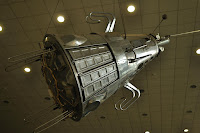Looking through my Smithsonian Air and Space book and the Soviet Space history books I got recently, I was reminded of the huge difference in technology between Russia and the United States. Whilst the first american satellite was the baseball like Vanguard, which struggled to leave the pad - the soviets were preparing Object D, a trabant sized orbiting laboratory close to three tons. As the Kremlin were keen to snatch a propoganda victory over the struggling US, the Chief Designer, Korolev was put under pressure to produce results. So Sputnik 1 was hastily assembled and shot into orbit to worldwide acclaim. Meanwhile Object D would eventually be launched successfully as Sputnik 3, shortly after.
The odd cone-shaped body has always fascinated me, with its multitude of curved antennae, so I decided to make something loosely based on the design. Using a mustard bottle top, some paperclips and two of the ridiculously fiddly tools that Apple provide for fishing a sim out of an iPhone, I set to. A handful of model parts from the scrap box and voila!
In order to balance out the homespun space race, I whipped up a US Ranger analogue too, in homage to the lunar surface plotting series of satellites.
 |
| RANGER 4 |
 |
| SPUTNIK 3 |






I like those. I also like the way the pictures look like Brook Bond space cards!
ReplyDeleteA fortunate side effect Kev!
ReplyDeleteThey both look most impressive.
ReplyDeleteI understand that the Russian space engineers said their rockets didn't look like the American ones because they had not seen the same (influential) science fiction films!
I much prefer the more industrial look of the soviet era vehicles. The proposed LOK Moon Lander is much cooler looking than the LEM.
ReplyDeleteYour homemade Ranger is excellent! And I agree with you re: the cruder "industrial" look of Soviet Space hardware. US Spacecraft look so sterile, and there is no more boring color than white...
ReplyDeleteThank you, I need to attempt the card Sputnik 3 shortly too!
ReplyDeleteRe: paper modeling, the secrets are careful scribing, and discrete gluing. And it is harder than it looks, lemme tell ya! There is a fab website on paper modeling called PaperMau, if you want to see some jaw-dropping examples of the high art of paper models.
ReplyDeleteIm going to photocopy the original and have a dry run, as Id hate to mess up the model.
Delete